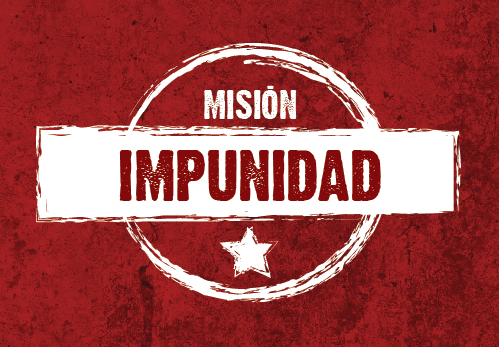Por Juan Francisco Alonso
Impunity reigns with common familiarity on the lands of Lebrún, near Petare, Caracas, purchased in 2005 by the Supreme Court (TSJ) for over 78 million bolivars to build “Judicial City” of Caracas, an enormous complex that would house the nearly 300 courts in the capital city.
Although the initiative ended up costing its sponsor—chavista deputy-turned-judge Luis Velásquez Alvaray—his job, so far no one has been prosecuted in this case. In fact, the scandal was revealed by the then Minister of the Interior and Justice, Jesse Chacón, who accused Velásquez of making the purchase through “a direct award of a remodeling contract (…) allegedly breaching the Procurement Law.”
A Bit of History
After being appointed Justice of the Constitutional Chamber in December 2004, Velázquez was chosen by most of his colleagues at the Supreme Court as Executive Director of the Judiciary (DEM), and he began to promote the project of “judicial cities,” with the support of then Presiding Justice of the Supreme Court, Omar Mora Díaz and the rest of his peers. Only Justice Blanca Rosa Mármol de León opposed the proposal, which involved scrapping the plan to build courthouses, which were being built since the 1990s around the country, with the support from the World Bank.
Within weeks of taking the reins of the agency that administers 85 percent of the funds of the Judiciary, the judge entered into discussions with Electricidad de Caracas to buy 16,000-square-meter land plot and a 7-storey building for 26.8 million bolivars and another plot from Inversiones AZ2000, some 11,686 square meters smaller than the former, and a 4-story building, but for a higher amount (50.1 million).
The latter company, established on September 3, 1999 by the Panamanian Edgar Azrak and Venezuelan Maritza Charr Arslanian, with capital of just one million bolivars at the time (Bs.1,000 now) for the “purchase, sale, import, export, distribution, storage, representation and manufacturing of clothing, footwear and hats, and fabrics and textiles in general, leather goods,” was joined in 2002 by Antonio Chambra, owner of Traki department stores; and in 2005, José Luis Iglesias, owner of Pepeganga, acquired the majority of shares.
A month and a half before the negotiations with the DEM were completed, AZ2000 changed its legal name and its purpose, which was now “everything related to real estate investments, purchase, sale, management, development, construction, renovation and remodeling of buildings and investment in companies in the sector.”
In spite of this fact, Velázquez signed a contract for more than 30 million bolivars for the purchase of not only the land and a building from this company, but also for the refurbishment. Minister Chacón learned about these irregularities, and headed a Ministerial Commission against Corruption, which requested the Republican Moral Council to initiate proceedings to remove the judge from his post.
In May 2006, the then Attorney General Isaías Rodríguez; the Comptroller General, Clodosbaldo Russián; and the Ombudsman, Germán Mundaraín, admitted the petition and said there was “serious misconduct” of the judge, who two months later was dismissed by the same National Assembly that appointed him.
Although Velázquez always denied any wrongdoing, he refused to go to Parliament to defend himself, and merely sent a document, and immediately fled to Costa Rica, where he remains as a refugee. In 2010, he denied to the press that he was involved in crimes of evasion of bidding processes, collusion with contractors and embezzlement, charges brought by the Prosecution, and attributed everything to a campaign against him hatched by Chacón and the former Vice President José Vicente Rangel, who according to him, protected a group of corrupt judges, prosecutors and lawyers that he supposedly fought against at the Supreme Court.
“I have no relation with them (businessmen Iglesias and Chambra) and I do not know these gentlemen. I did not sign any agreement. I implemented a decision overwhelmingly approved at the Plenary Session. What I did was to stop [the project] immediately because it was criticized. My timely action prevented damage to the nation,” he said.
Into Oblivion
Ten years later, on the grounds of Lebrún, the black-robe-clad men with briefcases full of laws and codes are nowhere to be seen. Neither are police officers or people eager to get justice for murder, theft, or to obtain a divorce or to sue for child support, because not a single courthouse was built. In fact, there are a couple of Mision Vivienda apartment buildings that house just over 200 families, because in 2012 the then president of the Supreme Court, Justice Luisa Estella Morales, decided to give away the land to the government, saying the judiciary did not need it.
Velázquez’s flight is the reason for which Public Prosecutor Ministry order to stall the investigation, which has only been partially reactivated in 2011, when the former judge was briefly detained in Colombia, where he made a stopover; and Venezuela tried to get his extradition, to no avail due to his refugee status.
However, no one else has been charged for this case, not the entrepreneurs or any former director of the DEM, or the judges who gave the green light for the controversial project, which from the very beginning raised questions at the Supreme Court.
https://www.youtube.com/watch?v=MdUB3rzzcVw
